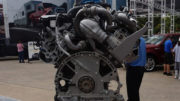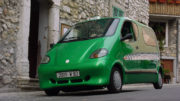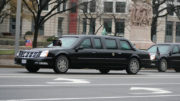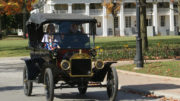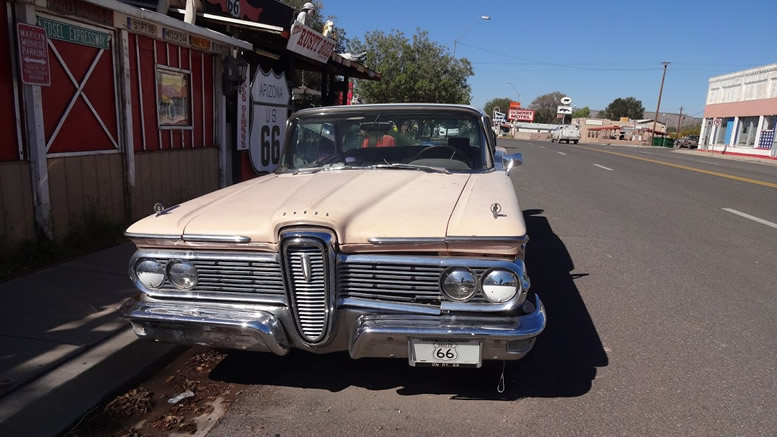 The Edsel, a then-new make of automobile manufactured by the Ford Motor Company, was introduced amidst a considerable amount of publicity on September 4, 1957. Research and development had begun in 1955 under the name “E-car” which stood for “Experimental car”.
The Edsel, a then-new make of automobile manufactured by the Ford Motor Company, was introduced amidst a considerable amount of publicity on September 4, 1957. Research and development had begun in 1955 under the name “E-car” which stood for “Experimental car”.
This represented a new division of Ford alongside Ford, Mercury, Lincoln and Continental. The short-lived Edsel division existed from November 1956 until January 1958.
For the 1958 model year, Edsel produced 4 models, including the larger Citation and Corsair, and the smaller, more affordable Pacer and Ranger. The Citation came in 2 door, 4 door, and two door convertible versions. The Corsair came in 2 door and 4 door versions. The Pacer came in 2 door, 4 door, 2 door sedan, and 2 door convertible. The Ranger came in 2 door, 4 door, 2 door sedan and 4 door sedan versions. The Bermuda Wagon, Villager Wagon, and Roundup Wagon were based on the two smaller Edsel models, and shared body structure with the ’57-59 Ford wagons. It included several features that were, at the time, cutting-edge innovations, among which were its “rolling dome” speedometer and its “teletouch” transmission shifting system, on the center of the steering wheel. 63,110 Edsels sold the first year, below expectations but the second largest car launch for any brand to date. Only the Plymouth introduction in 1928 was better.
For the 1959 model year there were only 2 Edsels: the Ranger and the Corsair which was really a relabeled Pacer. The two larger cars were not produced. The new Corsair came in 2 door, 4 door, 4 door sedan, and 2 door convertible. The Ranger came in 2 door, 4 door, 2 door sedan and 4 door sedan and the Villager station wagon. 44891 cars sold in model year 1959.
For the 1960 model year, Edsel’s last, only the Ranger and Villager were produced. A mere 2848 cars were produced before the Edsel was dropped on November 19, 1959.
The Edsel is most famous for being a marketing disaster. Indeed, the name “Edsel” came to be synonymous with commercial failure, and similar ill-fated products, such as the Betamax, have often been colloquially referred to as “Edsels.”
After an initial United States sales goal of 100,000 – 200,000 for the model year 1958, the Edsel went on to sell only 100,847 in the U.S. over the course of the three years it was in production, with an additional 7,431 sold in Canada, and a bare handful overseas.
Several reasons are given for its downfall. One is consumer letdown following the large publicity buildup prior to the model’s release. The campaign cost Ford $250 million, and included “teaser” advertisements in magazines showing pictures of the car highly-blurred or wrapped in paper.
The name of the car, Edsel, is also often cited as one reason for its unpopularity. Ford ran internal studies to decide on a name. They reached no conclusions. Ford hired the advertising firm Foote, Cone and Belding to come up with a name. Ford also asked poet Marianne Moore for suggestions, and she submitted a list which included “The Intelligent Whale,” “The Utopian Turtletop,” “The Pastelogram,” and “The Mongoose Civique.” All these outside ideas were rejected, and at the behest of Ernest Breech, who was chairing a meeting in the absence of Henry Ford II, the car was finally called “Edsel” in honor of Edsel Ford, former company president and son of Henry Ford. Marketing surveys later found the name was thought to sound odd and therefore was unpopular with the public; additionally, some sources claim that the decision to name the car after Edsel Ford was disapproved of by the Ford family from the very beginning.
Perhaps the most important factor in the Edsel’s failure, however, was that when the car was introduced, the U.S. was entering a period of recession. Sales for all car manufacturers, even those not introducing new models, were down; consumers entered a period of preferring less expensive, more fuel-efficient automobiles. The Edsel, moreover, was priced higher than comparable models offered by competing automotive firms at the time. In this respect it was not a failure while it did not hit it sales target based on 1955 sales numbers, it did achieve the projected percentage of sales for its class. The 100,000 cars target was 3.3% of mid-size cars sold in 1955 when the design process began, the Edsel achieved 5% of mid-size cars sales in 1959 when the car was first sold. Several other car companies did not survive this market downturn: Nash Motors and Hudson closed in 1957, Packard in 1958, and De Soto in 1960.
Various other problems were cited, including the unpopularity of the Edsel’s trademark “horsecollar” grille, which made it stand out from other cars of the period. A widely circulated wisecrack at the time was that “It looked like a Merc sucking on a lemon.” There were also reports of mechanical flaws in the models originating in the factory, due to lack of quality control and confusion of parts with other Ford models. Edsels in their first (1958) model year were made in both Mercury and Ford factories; the longer wheelbase models, Citation and Corsair, were produced alongside the Mercury products and the shorter wheelbase models, Pacer and Ranger, were produced alongside the Ford products. There was never a stand-alone Edsel factory devoted to soley Edsel model production, therefore the desired quality control of the different Edsel models was difficult to achieve for the new make of car.
The “horsecollar” grille was dropped for the 1960 model; 1960 Edsels had a body-type almost indistinguishable from the Mercury cars released that year. The Edsel was discontinued after truncated production of the 1960 version in November, 1959.
The scheduled 1961 Edsel Comet compact car was relabeled the Mercury Comet and sold more cars in its first year than all models of Edsel ever produced. Styling touches seen in the Comets sold to the public that allude to being part of the Edsel family of models include the rear tailfins (though canted diagonally), the tail light shape (reminiscent of the original 1958 Edsel) and the front grille (roughly similar to the 1960 Edsels).
Fewer than 6,000 Edsels currently survive and today they are considered collectors’ items, convertibles sometimes selling for over $20,000 if in good condition. (As usual with classics, hardtop models are worth considerably less, station wagons less than that, and sedans least of all.

